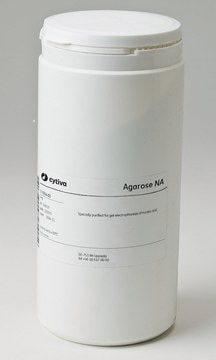A4018
Agarose, low gelling temperature
Synonym(s):
2-Hydroxyethyl agarose
Sign Into View Organizational & Contract Pricing
All Photos(7)
About This Item
Recommended Products
biological source
algae (marine)
Quality Level
form
powder
technique(s)
cell culture | mammalian: suitable
EEO
≤0.10
transition temp
congealing temperature 26-30 °C
gel strength
≥200 g/cm2 (1% gel)
Looking for similar products? Visit Product Comparison Guide
General description
Agarose is a polymer extracted from agar or agar-bearing marine algae. This purified linear galactan hydrocolloid comprises alternating co-polymers D-galactose and 3,6-anhydro-L-galactose units connected by α-(1→3) and β-(1→4) glycosidic bonds. Agarose is highly biocompatible and possesses variable mechanical and diffusion properties. Agarose can be used as a gelling agent, to separate nucleic acids electrophoretically. Low melting or low gelling temperature agarose is produced by hydroxyethylation of agarose. It is usually used for the isolation of separated DNA fragments. DNA fragments of the equal size will take longer time to move through a low melting agarose gel compared to a standard agarose gel.
Application
Gels exhibit excellent clarity and are particularly useful for the preparation of media containing heat-labile materials. Recommended for preparation of agarose beads.
Agarose, low gelling temperature has been used:
Agarose, low gelling temperature has been used:
- to immobilize zebra fish embryos during in vivo imaging experiments
- as a constituent of defined medium to culture bovine nucleus pulposus (NP) cells
- as a hydrogel, a scaffolding material for dental pulp regeneration
- in the form of pellets to determine the surface pH and conductivity of an acrylic emulsion film
Quality
A low gelling temperature derivative with unique gelling properties.
Analysis Note
The following is a list of properties associated with our agaroses:
Sulfate content - used as an indicator of purity, since sulfate is the major ionic group present.
Gel strength - the force that must be applied to a gel to cause it to fracture.
Gel point - the temperature at which an aqueous agarose solution forms a gel as it cools. Agarose solutions exhibit hysteresis in the liquid-to-gel transition - that is, their gel point is not the same as their melting temperature.
Electroendosmosis (EEO) - a movement of liquid through the gel. Anionic groups in an agarose gel are affixed to the matrix and cannot move, but dissociable counter cations can migrate toward the cathode in the matrix, giving rise to EEO. Since electrophoretic movement of biopolymers is usually toward the anode, EEO can disrupt separations because of internal convection.
Sulfate content - used as an indicator of purity, since sulfate is the major ionic group present.
Gel strength - the force that must be applied to a gel to cause it to fracture.
Gel point - the temperature at which an aqueous agarose solution forms a gel as it cools. Agarose solutions exhibit hysteresis in the liquid-to-gel transition - that is, their gel point is not the same as their melting temperature.
Electroendosmosis (EEO) - a movement of liquid through the gel. Anionic groups in an agarose gel are affixed to the matrix and cannot move, but dissociable counter cations can migrate toward the cathode in the matrix, giving rise to EEO. Since electrophoretic movement of biopolymers is usually toward the anode, EEO can disrupt separations because of internal convection.
Storage Class Code
11 - Combustible Solids
WGK
WGK 3
Flash Point(F)
Not applicable
Flash Point(C)
Not applicable
Personal Protective Equipment
dust mask type N95 (US), Eyeshields, Gloves
Choose from one of the most recent versions:
Certificates of Analysis (COA)
Lot/Batch Number
Don't see the Right Version?
If you require a particular version, you can look up a specific certificate by the Lot or Batch number.
Already Own This Product?
Find documentation for the products that you have recently purchased in the Document Library.
Customers Also Viewed
Viscoelastic properties of dental pulp tissue and ramifications on biomaterial development for pulp regeneration
Erisken C, et al.
Journal of Endodontics, 41(10), 1711-1717 (2015)
Agarose gel electrophoresis for the separation of DNA fragments
Lee PY, et al.
Journal of Visualized Experiments, (62) (2012)
Methods in Enzymology, 135, 223-223 (1987)
In vivo imaging of zebrafish retina
Williams PR, et al.
Cold Spring Harbor Protocols, 2013(1) (2013)
Testing the Waters: New Technical Applications for the Cleaning of Acrylic Paint Films and Paper Supports
The Book and Paper Group Annual, 32, 43-51 (2013)
Our team of scientists has experience in all areas of research including Life Science, Material Science, Chemical Synthesis, Chromatography, Analytical and many others.
Contact Technical Service



